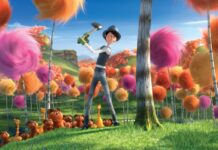Nickelodeon’s animated series, “Avatar: The Last Airbender” (2005-2008) was one of their most successful shows. With a massive following and an endless amount of positive reviews, the show has become a cult classic and many fans’ top favorite series. In 2018, Netflix announced a “reimagined, live-action” series from the original cartoon. People were then split as they were hesitant about how the series would turn out to be. On Feb. 22, the eight-episode Netflix series was released and had generally mixed reviews from viewers.
“Avatar: The Last Airbender” is a fantasy action television series in a world ravaged by war and split into four nations: the Water Tribes, Earth Kingdom, Fire Nation and Air Nomads. Some select people can “bend” and manipulate one of the four elements based on which nation they belong to. The Avatar is the person who can master all four elements while being tasked with maintaining balance and peace. However, after the Fire Nation attacked, the Avatar vanished. A hundred years later, the Avatar, Aang (Gordon Cormier) reemerges as the Fire Nation is close to winning the war. Although he still has much to learn, he begins his journey to save the world while making lifelong friends.
One of the few redeeming qualities of the show lies in the character casting and the proper representation of their backgrounds. In the original cartoon, many characters were of Asian and Indigenous descent. Netflix made an effort to cast culturally appropriate actors according to their roles that weren’t white-washed. With actors fitting their characters such as Kiawentiio Tarbell and Dallas Liu for Katara and Prince Zuko, respectively, the show demonstrated their ability to remain true to the source in this particular sense. Kiawentiio has Indigenous background, as she was born into the Mohawk family and Liu is of Chinese Indonesian descent.
The one exception to the representative ensemble is Ian Ousley who plays Sokka. Despite being described as Native American and of the Cherokee tribe, it was revealed that he was not enrolled in any of the federally recognized Cherokee tribes. As a result, fans were outraged at the lying and casting of Ousely. However, many viewers still praised the actors for fitting into their roles and being physically similar to the characters themselves.
With a few outliers, the acting in the show fell incredibly flat. The wide range of zany emotions that breathed life into the cartoons was completely absent in the live-action cast as the live-action portrayals of characters felt as if they had the charm sucked out of them. This was especially evident with Iroh (Paul Sun-Hyung Lee) and Zhao (Ken Leung). The fact that Sun-Hyung Lee as Iroh scarcely smiles or cracks any jokes completely sabotages his character and, similarly, Leung fails to capture the menace of the scheming Zhao in a superficially, one-noted performance.
Despite most of the cast’s mediocre acting, one standout character portrayal was Dallas James Liu’s Zuko. Liu nails the intense, fiery Zuko with a one-tracked mind to capture the Avatar containing a bit of sassiness that rounds out his character. An honorable mention would also be Suki’s (Maria Zhang) brief acting performance that captured a strong, fierce warrior who bests her enemies, yet has an adorable, wide-eyed curiosity and yearning to see the world.
Another major low of the series is the writing, which translated into some awkward dialogue between the characters that diminished their performance. There were particular scenes in which the dialogue felt too forced, such as giving Aang inspirational lines that felt unnatural in the moment. Additionally, the writing often brought the characters down, diminishing the actors’ natural charm that could have contributed to their roles. The awkwardness of various lines was enough to make viewers cringe and consider not continuing their watch.
While the show tries to find a middle ground between modern times and the original story that came out almost two decades ago, the changes made to characters often bring them down. For example, not making Sokka a misogynist at the beginning of the show diminishes the potential for his character growth. Additionally, it makes his character less dynamic when compared to the original.
The action sequences in the show have some merit as they demonstrate the elemental bending with passing-grade computer-generated imagery effects. However, what stunts the potential of the live-action fight scenes is the dizzying high amount of cuts during these scenes. While this decision was probably made to create a sense of dynamism, it comes off as a cheap crutch and instead disorients the viewer. So, instead of producing any fun, awesome action, Netflix viewers are instead treated to a viewing experience that violently induces nausea.
It doesn’t help either that the visuals are mostly lackluster. The green screens are so apparent that the poorly rendered backgrounds take viewers out of the immersion.
The costume design also comes off quite cartoony and off-putting, using vivid and bright colors. While it serves to distinguish the characters by the different nations, it loses a gritty edge that would have been cohesive with its more adult take on the original. The stylistic choice, then, just doesn’t feel organic and is awkwardly mixed into a young adult story.
Another issue many fans had with Netflix’s live adaptation was that it was done before and failed. In 2010, a live-action film “The Last Airbender,” directed by M. Night Shyamalan, was released. The movie had many things wrong with it such as the writing, white-washed actors and bad visual effects. The Netflix series was a bit better than this movie when comparing the two. For the visual effects and representative cast, the series excels more in this regard.
Generally, although seeing the representation and shots from the cartoon being made into live-action is intriguing, butchering the story and losing its true meaning diminishes the qualities that make the overall story so good. There is a struggle to translate the action and fluidity of the cartoon into live-action, which is evident in both the movie and the Netflix series.
Despite the shortcomings of the show and few highlights, new viewers might like the Netflix show. However, that might not be the case for fans, especially if they hold the original cartoon in high regard. Overall, the reception from both viewers and fans is mixed with some liking it when it stands on its own versus when it compares to the original.
Verdict: Netflix’s live-action adaptation of “Avatar: The Last Airbender” has many lows and very few highs. Ultimately, it will have viewers wanting to return to the original series instead.







